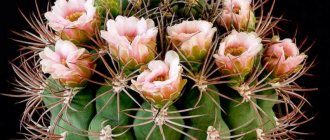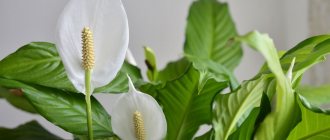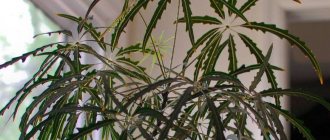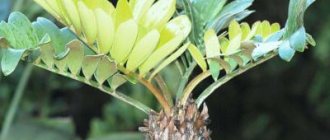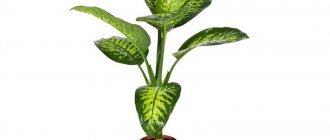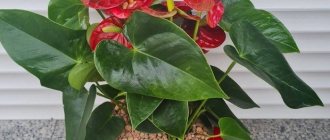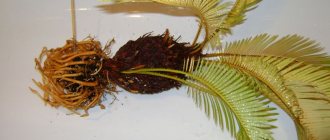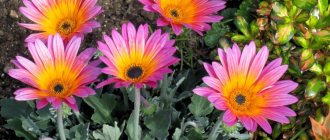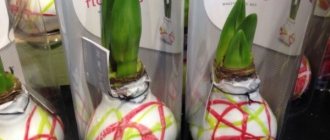Many indoor plants are known for their magnificent flowering: violets (Saintpaulias), geraniums (pelargoniums), begonias, orchids - collectors collect the most unusual specimens, and breeders replenish collections with new, even more exotic varieties. But once the flowers fade, many of the exhibits turn into ordinary green grass on the windowsill.
But alocasia is always beautiful, because its main advantage is not its flowers, but its leaves. They are very dense, leathery, with well-defined venation. If you did not know that the leaves were alive, they could be mistaken for a skillful product of a jeweler or engraver.
Alocasia came to our homes from the countries of Southeast Asia and Central America. They bloom very rarely and rather inconspicuously.
About the plant
Alocasia is a large, evergreen, herbaceous plant. As a rule, it has a developed aboveground stem, covered with scars - leaf traces of dead leaves. Young plants have a shortened stem. At the top of the stem there are several very large oval-arrow-shaped leaves.
Its leaves are thick, dense and almost leathery. Leaf blade with thick veins protruding on both sides; leaf petioles are long, succulent, with a long sheath. With good care, the plant develops 6-7 leaves, and the size of the leaf blades can reach 50-80 cm in length.
On a note !!!
The leaves have aqueous stomata-hydathodes, through which droplets of water are released in wet weather or when overwatered.
Sometimes it blooms in summer. The flowers are very small, collected in a spadix, equipped with a large light cover.
Alocasia flower
Alocasia is a fairly unpretentious plant that requires regular but simple care. It grows well in warm and humid microclimates. If you provide your tropical beauty with conditions close to natural, then she will delight you with her exotic beauty.
On a note !!!
If the leaves on an alocasia periodically turn yellow and disappear (one at a time, and not all at once), this is a normal process - a new one is already growing in place of the missing one.
Alocasia: lighting
Alocasia is a light-loving plant, but it needs to be shaded from direct sunlight. The best location for the flower will be windows facing east. The flower will feel comfortable on the western side, but in the south its leaves will wither. In this case, as mentioned above, shading will be required.
But even if protected from bright sunlight, alocasia should not be severely oppressed. In this case, dark spots may appear on the leaves and there is a risk of the plant wilting. The color of the foliage may also change.
Some types of alocasia, in particular copper-red and Amazonian, require additional lighting in winter.
Why did alocasia become a houseplant?
Have flower growers ever wondered why from time immemorial, by hook or by crook, travelers and botanists brought overseas plants from distant countries? Why did most of them not disappear, but multiply in hybrid forms? Some travelers risked their lives to get a new specimen for their botanical garden. Later it turned out that in addition to beauty, plants are priceless for their medicinal properties. It turns out that they not only absorb the hostile substances around us, but process them into poisons, which heal in small quantities.
Our ancestors did not have as much knowledge as they do now, but they intuitively selected and brought useful medicinal plants, which became homemade. Therefore, an indoor alocasia flower in an apartment poses a danger to children and animals, and it should be cared for with protective gloves. But people love it, and they gave it their affectionate names - trefoil, weatherman. In folk medicine of eastern countries, among tropical natives, this plant is used to treat serious diseases such as tuberculosis, cancer, and ulcers of various origins. Look at the photo of the oleander!
Alocasia: watering and air humidity
Abundant in summer, the soil should never dry out. Water frequently with soft, settled water so that the soil in the pot is constantly moist (it is advisable to immediately drain the water from the pan). In winter, watering alocasia is moderate and very careful. For most species, overwatering leads to root rot.
Watering Alocasia
Alocasia loves high humidity. In hot summer weather it needs spraying. To create additional air humidity, you can place the pot with the plant on a tray with wet expanded clay or pebbles.
Features of home care
To grow an alocasia flower, caring for it at home must be regular and continuous. Then the plant will respond with rapid growth and reveal itself in all its glory.
Temperature
Alocasia - home care, description of Polly and Amazon varieties
Temperature is an important part of caring for this native of the hot tropics. In summer, the permissible range is 20-27 °C. If it is a little hotter, the flower will tolerate it normally, but constant spraying will be required; low temperatures, on the contrary, are intolerable. The plant will stop growing and developing. In winter, the minimum permissible value is 15 ° C, but it is better if it does not reach it.
Important! Drafts are unacceptable, but regular ventilation is required to avoid air stagnation in the room.
Lighting
The lighting should be bright, but at the same time diffused. Direct sunlight can cause burns. With insufficient light, flower growth slows down and the leaves become smaller. The optimal placement is western or eastern window sills, in the south you will need shading in the summer months, on the north side - additional lighting in winter.
Watering
Watering must be approached very carefully. Excess moisture is dangerous, as is its lack. The frequency of the procedure directly depends on the temperature. For example, in winter, when there is insufficient light and low temperature, you need to water the flower only once a week. In summer it is necessary to water 3 times more often. The water should not be cold, soft, well settled.
Note! Before watering the alocasia, you need to make sure that the soil is dry by 5-7 cm. To reduce the evaporation of moisture, you can put a layer of mulch, for example, moss, on top of the substrate.
Spraying
This procedure is necessary for the plant due to the tropical rainforest where it comes from. With its help, the flower develops and grows more actively, and its immunity is also strengthened. It is preferable to spray the underside of the leaf blade, daily in summer, less often in winter, depending on the lighting and temperature. Sometimes it is useful to take a warm, refreshing shower. The main thing is to do this carefully, trying not to damage the delicate leaves.
Humidity
Alocasia loves high humidity, so it requires regular spraying. Also, there should always be a bowl of wet expanded clay or water nearby. The best option is a humidifier.
Priming
The most important rules when choosing a substrate are looseness, breathability, and lightness. The simplest solution would be to purchase ready-made soil for aroids. You will need to add crushed charcoal and soil from a coniferous forest to it. To prepare your own substrate you will need:
- soil for orchids (4 parts);
- garden soil (3 parts);
- peat (2 parts);
- perlite (1 part);
- sphagnum (1 part).
For your information! The soil for all types of alocasia should be slightly acidic. The exceptions are copper-red and squat varieties, which require neutral acidity.
Feeding
Fertilizer application is necessary from the end of March to the end of September 2 times a month. After watering, the soil is fertilized with any complex composition for decorative foliage plants, diluted by half. Feeding with bird droppings is also possible, but it is too concentrated, so it must be diluted with water in a ratio of 1:30.
Features of winter care during the dormant period
From the end of September to the beginning of March, alocasia enters a dormant period associated with shorter daylight hours and a decrease in temperature. Therefore, it is necessary to completely stop feeding and reduce watering and spraying.
Alocasia: soil
Alocasia loves nutritious, loose and breathable soil with a slightly acidic alkaline environment (pH about 5.5). Mixtures of the following composition are well suited for planting:
- humus, leaf, turf soil, peat and sand in a ratio of 2:2:2:1;
- leafy, coniferous soil, peat, sand in the ratio 1:1:1:0.5;
- leaf, peat soil, crushed sphagnum, sand (2:1:0.5:1).
You can plant alocasia in a ready-made store-bought mixture intended for indoor plants.
In a good soil mixture, the plant exhibits all its decorative qualities. It grows and blooms well.
Where and at what price can I buy it?
You can buy an adult plant in a store or on the Internet (by advertisement). The first option is more preferable, since this gives the buyer more confidence that he is buying a healthy plant of the desired variety.
- The price of Silver Dragon is on average 1300-1400 rubles .
- Pink Dragon costs more - from 1500 rubles .
Where can I get planting material?
The plant's seeds are practically not sold, but seedlings can be purchased at a garden center or by advertisement. The price will be approximately the same - 250-300 rubles per seedling.
Alocasia: feeding
Fertilizer. In spring and summer, alocasia requires feeding every 2-3 weeks. It is best to use complex mineral fertilizer for indoor plants. Organic matter should be added carefully, as it contains a large amount of nitrogen, which can cause rotting of the flower, leaves and stem.
Fertilizers for alocasia
It is best to alternate feedings. For example, foliar feeding is applied first. Here liquid fertilizer is used for decorative deciduous plants. It is distributed over the leaves. After 14 days, the plant is watered with a solution containing mineral fertilizers. Mineral fertilizers can not be diluted in water, but used in dry form. Several granules, about 7-8 pieces, are placed on the ground after watering the plant. They gradually begin to melt and with each watering, along with water, they fertilize the soil.
Important!!!
Fertilizing should be used only in the recommended proportions, because an excess of fertilizers is no less dangerous for the plant than a deficiency.
When foliar feeding, not only ready-made liquid fertilizers are used, but also the HB-101 preparation, biological additives, and chelates.
Alocasia: transplant
The soil for alocasia must be nutritious. For good growth, you need a substrate that is well permeable to moisture and air and has a slightly acidic reaction (pH about 5.5).
Alocasia transplant
Replanted annually, usually in early spring, mature plants after two years, soil:
- 1 part leaf soil;
- 1 part coniferous;
- 1 part peat;
- 0.5 parts sand.
An earth mixture made up of sand, garden soil and greenhouse soil in equal parts is suitable.
On a note !!!
For large specimens, replanting can be replaced by transferring it to a pot of larger diameter. It is better to take tall pots. Good drainage is necessary.
Plant care at different times of the year
| Season | Lighting | Air temperature | Fertilizer | Transfer |
| Spring | At any time, the flower will appreciate soft, diffused light. The shade can lead to the death of the plant, and too bright sunlight can burn the foliage. This is especially important for alocasia with leaves of bright colors. | During this period, the plant is comfortable at 20–26 degrees | From April to October, nitrogen and other mineral-based supplements should be applied. The benefits from them will be maximum | Held annually in spring or early summer |
| Summer | ||||
| Autumn | 17–20 degrees is enough, occasionally you can lower the temperature to 16 degrees | The soil fertilization process is suspended | Not carried out. At this time, the plant is resting, and it is not recommended to replant it | |
| Winter |
Alocasia: reproduction
Alocasia can be propagated in different ways: by seeds, dividing the rhizome, suckers or daughter tubers, and stem cuttings.
Alocasia from seeds
Alocasia with variegated leaves cannot be propagated by seeds - variegated leaf characteristics are not expressed. Sow the seeds immediately after collection, shallowly in a light substrate (leaf or peat soil and sand). To ensure high humidity, cover the top with glass or film. Temperature 22-24°C and regular spraying. The seedlings are picked and then transplanted into small pots. Large leaves appear after a year.
Alocasia from seeds
Alocasia seeds
Alocasia offspring and daughter individuals
It is much easier to propagate alocasia by offspring or daughter tubers. When dividing the rhizome and preparing stem cuttings, do not forget to sprinkle the cut areas with charcoal. For rooting, the substrate is the same as for sowing seeds. You can cover the planted cuttings with film.
Reproduction of alocasia
Reproduction by cuttings
To do this, a bud is cut out from the stem of a large specimen along with the pulp adjacent to it. The surface of the cuts is sprinkled with crushed charcoal and placed in sand or a mixture of peat soil and sand, leaving the bud above the surface of the substrate.
Reproduction - the easiest ways to increase the amount of tropical beauty on the windowsill
Propagating alocasia is a fairly simple process, especially if you have already practiced on other plants. There are several ways, so you can choose for yourself what you like and what you can handle most adequately:
- cuttings;
- division of the root system;
- planting daughter nodules;
- sowing seeds.
The seed method, in my opinion, is the most labor-intensive and lengthy. Not only will you have to constantly ensure that the soil mixture is always slightly moist, but subsequently you will have to pick the young bushes several times. Of course, the choice is yours, if you are not afraid of difficulties, you can try your hand at growing alocasia in shifts.
Cuttings are a slightly simpler process, because you won’t need any special feats. Just cut off part of the plant and plant it in a small pot. There must be a greenhouse (a plastic bottle cut into two parts will work well for this purpose).
The easiest way to propagate is to divide the rhizome when transplanting or take several nodules from it. Here, too, do not forget about the greenhouse, so growth will begin much earlier.
I want to warn you that alocasia is a rather poisonous plant. If you have a growing baby in your family, a lover of indoor plants, try to place the bush so that the child cannot reach it. Also be careful when transplanting or propagating alocasia. It is best if you perform all work wearing rubber gloves.
Alocasia: pests
The most common pests of alocasia are aphids and spider mites. In addition, it is affected by mealybugs and scale insects. Dry air and high temperatures promote the appearance of pests. If pests are detected, if the infestation has not gone far, carefully wipe the leaves and stems with a soapy sponge. In case of severe damage, you can use Actellik solution (1-2 ml per liter of water) or another similar remedy.
Attention!!!
All organs of alocasia contain toxic substances, so you should be careful when caring for the plant, and wash your hands thoroughly after work. It is not suitable for landscaping children's institutions.
Alocasia, distinguished by its splendor and exotic beauty, is deservedly recognized as one of the most outstanding foliage and ornamental plants. Powerful specimens, reaching several meters in height, are a rich decoration of the interiors of public spaces: bright halls, foyers, rest rooms. Widely used in the creation of winter gardens and the design of artificial ponds and fountains. Only small young plants are suitable for keeping in rooms.
Plant pests and diseases
Alocasia, like other indoor plants, is not without problems with the occurrence of pests or diseases. To preserve the plant, you need to take timely measures to eliminate these problems.
What to do if problems appear with the plant?
Alocasia is not a very capricious flower, however, it does have some problems:
- The plant loses its growth rate: lack of nitrogen fertilizers, which can be compensated for with an aqueous solution of urea.
- Foliage withers: the soil is either too dry or waterlogged. In this case, you need to adjust the watering regime and, if necessary, replace the substrate in the tray.
- The color of the leaves turns pale: the flower lacks light, which can be increased by adding artificial lighting.
- The tips of the foliage dry out and turn brown: the air in the room is too dry or the plant does not have enough water. It is necessary to carry out regular spraying and watering with warm water.
- The leaves begin to rot: the plant is infected with root rot. It needs to be treated with an antifungal agent (“Fundozol”), the leaves that have rotted are removed. The plant itself requires transplantation into a substrate of a looser consistency.
Signs of infestation and pests
Alocasia is susceptible to infection by the following diseases and pests:
- Scale appears due to excessive moisture of the plant: the foliage of alocasia is covered with dark spots that also cover the stem of the plant. You can get rid of scale insects by spraying the flower with a solution of tobacco and soap mixed with kerosene. Pests should be removed with a cotton pad soaked in this solution.
- Aphids settle on the lower surface of leaves, which can cause them to curl and dry out. The flower must be treated with a special anti-aphid agent; after a day, the alocasia is washed and re-treated.
- A sign of a flower being damaged by a mealybug is the appearance of a whitish fluff and a stop in the growth of alocasia. The plant is treated with an alcohol solution, carefully wiping the foliage and stems.
How to deal with spider mites
The appearance of a small red spider should alert the owner; it could be a spider mite. It can cause alocasia a lot of trouble, including yellowing of the foliage.
You can get rid of spider mites by spraying the leaves with insecticides, followed by washing them with warm water. It is important to carefully treat the lower surface of the foliage, carefully removing all cobwebs.
Remedies for spider mites:
- tobacco infusion;
- pollination with store-bought insecticides (carried out only outdoors);
- ground sulfur;
- water.
Possible difficulties
When growing alocasia, you should pay attention to the following difficulties that gardeners usually encounter when growing this plant:
- Alocasia has stopped growing. This situation arises for two reasons: either the plant needs replanting or is experiencing a deficiency of minerals. The solution here is very simple; the flower needs to be transplanted into a larger pot or, if the container is normal for the plant, fed.
Alocasia diseases - Alocasia leaves wither. This problem occurs when the soil is excessively waterlogged. It can also occur when the earthen lump is very dry. In this case, it is enough to adjust the watering. If, even after normal watering, the leaves continue to wither, it means that the soil in the pot is too dense. In this case, you should change the soil to a looser and more breathable one.
- Alocasia leaves have turned pale or changed color. This situation occurs with aging and dying leaves. In place of the old fallen leaves, after a certain period of time, new leaves grow. The drawing on the sheet may fade due to lack of light.
- The tips of the leaves dry out and turn black. The reason is lack of watering, low light, low air humidity.
- Dark spots have appeared on the leaves of Alocasia. There may be several reasons: drafts, hypothermia, too dry or vice versa, damp soil, overdose of fertilizers. Dark spots sometimes appear due to mechanical damage, waterlogging of the soil and excessive application of nitrogen fertilizers. This situation often leads to the occurrence of fungal and bacterial rot. In this case, the rotten place is treated with fungicides or the plant is transplanted into new soil.
- Rotting of the rhizome. This problem occurs when the room temperature is low, there are drafts, and the plant is flooded so that the soil does not have time to dry.
Landing
Germinating seeds is the most time-consuming and labor-intensive way to obtain a plant. In addition, alocasia seeds quickly become unusable and this is quite difficult to determine when purchasing
You should choose seeds in the store carefully, and you need to pay attention to the following points:
- The packaging must be durable and free from any defects.
- The information on the packaging must be easy to read and the labels must be clear.
- The expiration date should be normal.
Seeds should be sown in the spring, when a gradual increase in air temperature begins and daylight hours increase.
Germination requires at least ten hours of intense light. If sowing is planned in February, additional lighting will be required. The soil required for seeds is the same as for adult plants.
- Seeds should be sown on moist soil without deepening them.
- Cover the top with glass and place it on the windowsill.
- The seeds must be periodically moistened with a spray bottle, as the soil must not be allowed to dry out.
In about 20 days they will hatch if the seed was of high quality. When sprouts appear, they need daily ventilation.
If you can’t grow alocasia from seeds or it seems too difficult, you can ask your friends for a tuber or leaf cutting of the plant.
Choosing a pot
Alocasia needs a tall and not too wide pot. You can even use narrow, spacious pots, because the plant has long roots. If you plant this plant in a wide and low pot, then very soon it will need to be transplanted into a new one, since the roots will grow into the drainage holes.
As for the choice of pot material, this point does not matter. It can be made of any material. However, the best option is always considered to be a ceramic pot without glaze.
What should the soil be like?
The soil for this plant should be light, loose and airy. It should also dry out quickly, as excess moisture causes the sensitive roots of the plant to rot. You can make a good mixture for alocasia if you mix:
- High peat.
- Ready soil for orchids.
- Garden soil.
This mixture will be an excellent soil that contains the nutrients the plant needs. And it will be able to develop properly and not lack oxygen.
Alocasia: types and photos
Alocasia has about 70 varieties. It can grow up to two meters or more in height. It grows not only at home, but also in the wild. Used as a garden plant in countries with warm climates. Below are the most popular and famous varieties cultivated by gardeners around the world.
Amazonian alocasia (Alocasia amazonica)
A hybrid often referred to as A. Sanderiana. Stem up to 15 cm tall; petioles 40-60 cm long, pinkish-green with dark transverse strokes. The leaves are elongated, thyroid-shaped, with well-defined lobes, shallowly notched at the base and along the edge, 40-50 cm long, up to 20 cm wide, dark green, with 5-8 pairs of white lateral veins with white stripes along them.
Amazonian alocasia (Alocasia amazonica)
Peduncle 20 cm long, spadix whitish-pink in color up to 8-10 cm long. The spathe is whitish-greenish, up to 20 cm long, about 10 cm wide. When grown indoors, it practically does not bear fruit.
Alocasia sanderiana
It lives in tropical rainforests, at an altitude of 300-600 m above sea level in the Philippine Islands. Plants with short tuberous rhizomes. Leaves are up to 30-40 cm long and about 15 cm wide, elongated-arrow-shaped, with notched pinnate lobes, green, with a dark metallic sheen; lateral veins and edges are whitish.
Alocasia sanderiana
The petiole is brown-green, 25-60 cm long. The species is cultivated in warm greenhouses. Widely used in work on Alocasia hybridization.
Alocasia lou
Homeland: Borneo, Malaysia. Reaches 1 m in height, the trunk is quite short; forms underground root suckers. The leaves are on long petioles, oval or arrow-shaped, solid green or with white veins, the reverse side of the leaf is purple-violet. The petiole is attached in the center of the leaf. The plates are bluish-green with a characteristic metallic sheen, the specks and veins are silvery.
Alocasia lou
Alocasia cucullata
Originally from China, India, Sri Lanka. Plant height from 60 to 100cm - photo of the plant. The stem is 3-6 cm in diameter. Petioles are usually up to 30 cm long, rarely up to 50-80 cm. Leaves are large, up to 1 m long and 60-80 cm wide, dense, usually inclined, notched at the base of the plate, short pointed at the apex, shiny, bright to dark. green.
Alocasia cucullata
At the point where the petiole is attached, there is a characteristic swelling on the upper side of the leaf. Only powerful plants with a lot of leaves bloom. Peduncle up to 20-30 cm tall; the blanket is fleshy, up to 10-15 cm long, 3-8 cm wide; the cob is shorter than the spathe. The berries are hemispherical, medium-sized, 6-8 mm in diameter. It forms daughter tubers that are located close to the main one.
Alocasia macrorrhizos
Synonyms: Indian arum (A. indica (Lour.) Spach), Indian arum (Arum indicum Lour.), large-rooted arum (Arum macrorrhizon L.), Indian alocasia (Colocasia indica (Lour.) Kunth). Homeland: India, Sri Lanka, Malaysia. The plant is quite large in size - photo of the plant. The stems reach 2 m in height or more, the petioles are more than 1 m long. The leaf blade is ovate-heart-shaped with well-defined diverging lobes at the base of the blade, from 50 to 90 cm long and 40-80 cm wide.
Alocasia macrorrhizos
Peduncle up to 30 cm long, with a yellow-green spathe, 18-24 cm long, the spadix is equal to the length of the spathe. The berries are bright red, shiny, up to 1 cm in diameter. As an edible and medicinal plant (tubers - the so-called giant taro) are common in the tropics.
Photo of blooming large-rooted alocasia. The juice in the leaves is poisonous (contains hydrocyanic acid), but the plant is used in Chinese medicine. Preparations from the stem are used for pain in the stomach, intestines, toothache, and cholera. The crushed tuber is applied to various tumors. Preparations from the leaves and the whole plant are recommended in the treatment of pneumonia and tuberculosis.
Alocasia is light-loving, not afraid of sunburn, and tolerates shading. Undemanding in cultivation, can grow in rooms with central heating. Due to its large size, A. macrorhizos is more suitable for offices and winter gardens.
The form variegata (Alocasia macrorrhizos var. variegate) - photo - differs from the original form in variegated leaves with large white spots and smaller sizes.
Alocasia odora
Synonym: Arum odorum G. Lodd. It grows in the Himalayas, in the south of the Indochina Peninsula, on the island of Taiwan, the Philippines. A herbaceous plant with a thick, strong, short, almost tuberous rhizome. The shoots are thick, up to 1 m tall. The leaves are beautiful, leathery, fleshy on long petioles. The length of the leaves can reach 1 meter and the width is 60-80 cm.
Alocasia odora
Young leaves are thyroid-shaped, old ones are narrow ovate, almost linear, with an arrow-shaped base. The lower protruding parts of the plate are fused with the petiole. Inflorescence – spadix – photo. The flowers are sessile with a specific scent. The spathe is about 20 cm long, covers the cob, bluish-green in color - photo. It rarely blooms in the room.
Alocasia cuprea K. Koch
Homeland - o. Kalimantan. One of the most decorative and small alocasias. Stem up to 10 cm long. (often underground). Petioles are 20-30 cm long, the leaf blade is heart-ovate, vertically directed, up to 25-35 cm long, 14-17 cm wide, semi-leathery, copper-green above with a metallic sheen, intense purple below; the attachment of the petiole to the blade is thyroid (not to the edge of the blade, but at some distance from it); at the point of attachment on the upper side of the plate there is a characteristic swelling.
Alocasia copper-red
Peduncles are collected in groups of 2-3 and up to 10-15 cm long, dark purple. Bedspread up to 15 cm long and width up to 8 cm; the cob is always shorter than the spathe. Does not bear fruit in cultivation. The plant contains poisonous sap that causes skin irritation, so you must wear rubber gloves and wash your hands thoroughly after handling.
Alocasia reginula Black Velvet
Synonyms: A. hybrid (A. hybr. 'Black Velvet'). Homeland: Borneo. Stem up to 10 cm long. The petiole is up to 15-25 cm in length, the leaf blade is heart-shaped, ovate, velvety, black and burgundy above, the veins form a white pattern, the bottom is green up to 25-35 cm long and 20-25 cm wide.
Alocasia Black Velvet
Peduncle up to 10 cm in length, white-pink spathe, 7-9 cm long. with a pink cob. Often blooms indoors.
Alocasia reginula
This species differs from Black Velvet in that its leaves are glossy and dark green with an elongated tip. A. reginula and Black Velvet are light-loving and tolerate direct sunlight, but should be shaded during the daytime. They tolerate shading.
Alocasia reginula
When and how does it bloom
It is very difficult to achieve flowering of a plant in a house or apartment. And this is only required if it is important for the owner that his alocasia turns out to be exceptional and still blooms.
Ctenanthus flower - home care
The inflorescence-cob consists of small pinkish flowers, covered with a white or green blanket. Many representatives of the aroids bloom this way, and the zamioculcas cob looks similar and even more attractive. Only an adult plant that reaches the age of at least 4 years blooms.
Important! Flowering greatly weakens the plant, the number of leaves may be reduced, and their growth slows down. Therefore, it is better to remove the cob as soon as it begins to appear.
Inflorescence spadix
